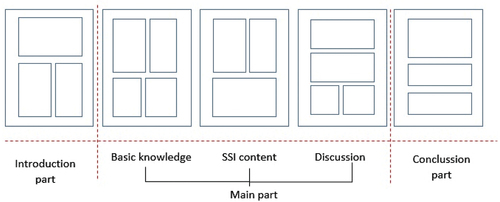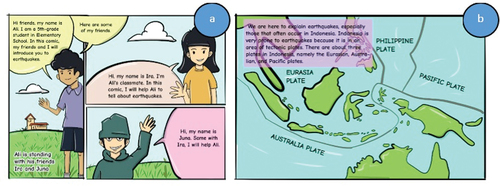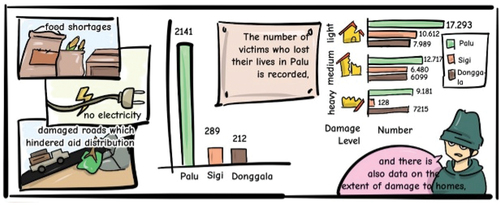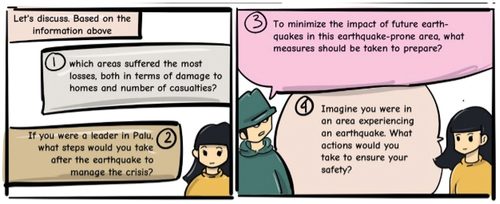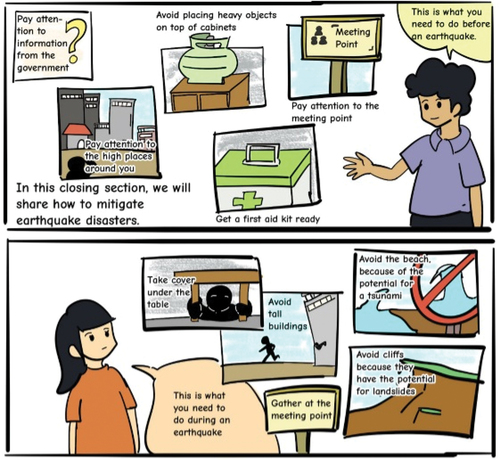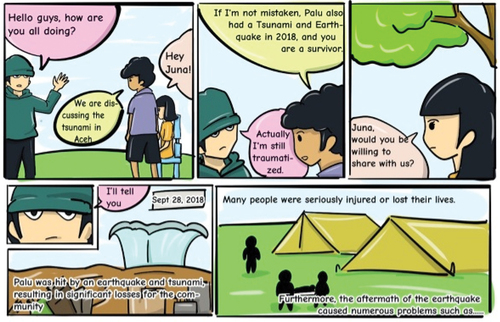ABSTRACT
Integrating socioscientific issues (SSI) into education is gaining widespread adoption in classrooms due to its positive impact on student’s critical thinking, environmental awareness, holistic knowledge and/or the idea of combining science and mathematics. This paper explores the idea of using comics as appropriate media for elementary school students to engage with SSI content. Because of the difficulties in integrating SSI into classrooms, SSI-based learning is more commonly applied in high school and higher education settings, with limited implementation in earlier education. To answer this gap, we developed comics that have SSI content for elementary schools. Comics are chosen as reliable tools for visualising and simplifying complex concepts and making SSI content more accessible and engaging. This paper describes our comics on earthquake-related issues in Indonesia and the principles that guided its design. SSI inherently involves multiple perspectives, so the integration brings together science, and mathematics within the one comic. In integrating different disciplines of comic content, we utilised the rule-of-five framework, widely employed to merge five representational models (experiential, verbal, numerical, visual, and symbolic) commonly used in developing content combining two or more different academic disciplines.
Introduction
Using socioscientific issues (SSI) as an instructional framework is increasingly recognised and applied within educational settings to enhance students’ critical thinking abilities and facilitate the application of learned concepts in real-world societal contexts (Zeidler Citation2014). Socioscientific issues refer to contentious matters within society that typically involve scientific dimensions (Zeidler Citation2014). Multiple studies have demonstrated that integrating SSI into the learning process directly influences students’ critical thinking skills (Cahyarini, Rahayu, and Yahmin Citation2016; Solbes, Torres, and Traver Citation2018), cultivates qualities associated with global citizenship (Lee et al. Citation2013), fosters creative thinking abilities (Indriani and Jayanti Citation2022), enhances soft skills, and promotes environmental awareness (Susilawati et al. Citation2021). These findings indicate that SSI hold the potential to nurture students who possess not only strong cognitive and psychomotor capabilities but also exhibit sensitivity towards societal conditions.
The incorporation of SSI is predominantly observed in high school and higher education contexts within the field of education (Aisya, Wibowo, and Aminatun Citation2016; Cian Citation2020; Dawson Citation2015; Wu and Yang Citation2022). This preference is attributed to the fact that these educational stages necessitate the development of proficient critical thinking abilities and the capacity to tackle contextual problems. Due to the absence of prior exposure to SSI during earlier education, students at these levels often need more preparation, leading to an extended period for teachers to integrate SSI into the classroom. In order to mitigate this challenge, we have initiated an approach that introduces SSI at the elementary school level. By doing so, we aim to familiarise students with SSI from an early age, enabling them to progressively build their critical thinking skills and problem-solving capacities over time.
Introducing SSI in elementary schools presents significant challenges (Dolan, Nichols, and Zeidler Citation2009). Various obstacles arise, including children’s cognitive development, which is primarily at the concrete operational stage at that age, and their limited capacity to comprehend the complexities inherent in SSI topics (Evagorou Citation2011). To deal with such obstacles, there needs to be more research on implementing SSI in elementary schools. These factors necessitate a meticulous and thoughtful approach that considers students’ psychological and cognitive abilities in constructively processing SSI-related information.
In light of the considerations above, we have employed an approach centred around creating educational comics to facilitate the introduction of socioscientific issues (SSI) in elementary schools. Integrating educational comics into the learning process has been widely adopted due to their potential to enhance students’ reading habits and positively impact their learning outcomes (Cohn Citation2013a; Lubis Citation2018). Additionally, comics possess unique advantage in visually simplifying intricate information, making complex concepts more accessible and comprehensible (Akcanca Citation2020; Barberis and Grüning Citation2021). Leveraging these strengths, we have utilised comics as a strategic method for introducing SSI in elementary schools.
Subsequently, multiple factors were considered in selecting the content for our educational comics. Among these considerations, we opted to focus on a topic that has recently garnered significant attention – the occurrence of earthquakes as a recurring natural disaster in various countries such as Japan, Indonesia, Peru, Turkey, and Mexico (Goltz et al. Citation2020; Gunawan et al. Citation2019). By centring our attention on post-earthquake issues, we aim to address subject matter that holds relevance and significance. Additionally, the decision to explore the subject of earthquakes in a comic for Indonesian students stems from Indonesia’s distinctive geological characteristics. This comics content allows students to gain familiarity with issues relevant to their country in general and their communities.
Indonesia, encompassing several tectonic plates (Eurasian, Australian, and Pacific Plates), is highly susceptible to earthquakes (Katili Citation1975; Verstappen Citation2010). Moreover, being positioned within the Ring of Fire – an area prone to volcanic activity – Indonesia also faces the risk of volcanic earthquakes (Pambudi Citation2018). These considerations strengthen our rationale for choosing earthquake-related content as the focus of our educational comics.
To enhance the depth and breadth of our content, we have incorporated scientific and social perspectives, as well as a mathematical perspective by integrating earthquake-related data into our educational comics. This approach aligns with the SSI framework, which emphasises inclusion of multidisciplinary perspectives to enrich students’ cognitive understanding (Presley et al. Citation2013; Zeidler et al. Citation2005). By intertwining mathematics and science, we aim to provide students with a comprehensive comprehension of SSI content, fostering critical thinking skills within the classroom. Moreover, this multidimensional approach also facilitates the development of students’ social awareness as they grasp the societal implications stemming from SSI. In summary, our comics establish connections between mathematics, science, and SSI content, resulting in a rich and multifaceted educational experience.
This paper describes the utilised comic format, primarily focusing on the content presented within the comics. Additionally, we elaborate on the visual representation techniques employed to convey this content in our comics. By detailing the chosen content and visual strategies, we aim to provide a thorough understanding of the structure of content and visual elements incorporated within our educational comics.
Connecting mathematics and science in comics
Establishing a connection between mathematics and science within the context of learning can be challenging, particularly when integrating these disciplines with SSI. Our comic strives to navigate this challenge by adapting the rule-of-five framework (Diaz Eaton et al. Citation2019), previously employed to unite mathematics and biology. This framework serves as a guide for us as we combine mathematics and science in our SSI content. This framework helps us bridge the gap between the disciplines, ensuring a cohesive integration of maths and science within the context of our comic.
The rule-of-five framework encompasses five distinct types of representational models: experiential, verbal, numerical, visual, and symbolic, all interconnected (see ). Experiential models involve tangible, concrete experiences such as virtual laboratories, animations, kinaesthetic activities, physical models, scientific experiments, case studies, and simulation-based investigations (Diaz Eaton et al. Citation2019). The verbal type entails hypotheses for experimental design, predictions, assumptions for mathematical modelling, simple descriptions of observations, and qualitative data (Diaz Eaton et al. Citation2019). Numerical models encompass data sets derived from model-based simulations, calculated data from other sources (derived data), and quantifiable data collected through experiments. The visual type comprises graphical representations and schematics. Lastly, the symbolic type encompasses formal mathematical constructs such as formulas, equations, algorithms, parameters, and state variables. The utilisation of these representation types can vary depending on the specific pathway being adapted, with all five types potentially employed or selectively utilised based on the instructional context.
Figure 1. The rule-of-five framework (Diaz Eaton et al. Citation2019, 805).
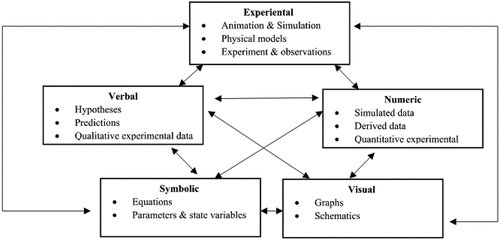
Adaptation of the Rule-of-Five Framework involves three distinct pathways: mathematical, statistical, and biological (Diaz Eaton et al. Citation2019). We have employed the mathematical and biological pathways in developing our comic designs. The selection of the mathematical pathway was driven by our emphasis on the numerical representation type, wherein we extensively utilise related data and employ numerical values to visualise information through graphs, thereby emphasising the visual representation type. Additionally, in certain sections of our comics, we also incorporate elements from the biological pathway to elucidate fundamental concepts. This integration allows us to transform verbal representations into visual representations, constructively conveying basic knowledge within the context of our educational comics.
Our approach to connecting mathematics and science within our comics content involves two key aspects. Firstly, we integrate both disciplines in a dedicated section that addresses fundamental knowledge associated with the subject matter, specifically focusing on earthquake-related concepts. This amalgamation enables us to present a cohesive and comprehensive understanding of the topic. Secondly, we combine mathematics and science when describing SSI within the comic. By incorporating both disciplines, we provide a multidimensional perspective on SSI, enriching the content and promoting a deeper comprehension of the societal implications.
Design of educational comics
In our study, in addition to the earthquake topic highlighted in this paper, we intend to create a collection of educational comic volumes that tackle a range of diverse socioscientific subjects. These topics encompass challenges related to water resources, shortages in electricity supply, global climate change, complexities in seaweed cultivation, and shifts in fundamental human necessities.
This section provides a comprehensive description of our comics design structure, detailing each part’s distinct components (refer to ). The design is divided into sections: introduction, basic knowledge, socioscientific issues, discussion of SSI, and conclusion. Each part is carefully crafted to serve a specific purpose and contribute to the comic’s overall narrative and educational objectives.
Introduction of comics
The introduction section of our comic introduces the characters and presents the initial conflicts or challenges. exemplifies the character introduction within our comic. We aim to enable students to differentiate between the various characters as the storyline unfolds. To facilitate this, we have ensured that each character possesses distinct characteristics, allowing students to distinguish and identify them easily. We have designed three main characters in this comic: Ali, Ira, and Juna. To help differentiate the characters, we incorporated variations in their clothing styles, colours, and morphological features, particularly their facial appearances. These design elements enhance each character’s visual cues and uniqueness, promoting better engagement and comprehension for students as they follow the narrative progression.
Subsequently, in , we introduce the underlying problem by elucidating the reasons behind Indonesia’s susceptibility to earthquakes as a precursor to delving into the detailed content of the comic. Within this context, our focus centres on introducing the concept of tectonic plates, as earthquakes in Indonesia are often attributed to tectonic activity. By highlighting the significance of tectonic plates, we aim to instigate curiosity and prompt students to question how the movement of these plates leads to earthquakes. It serves as a pivotal ‘trigger’ to stimulate critical thinking and curiosity among students, motivating them to engage with the comic and continue reading further actively.
Basic knowledge part
This section focuses on providing an in-depth scientific explanation of earthquakes. As illustrated in , we discuss various scientific factors contributing to earthquake occurrences. We highlight two common types of earthquakes: tectonic earthquakes resulting from shifting Earth’s plates, and volcanic earthquakes arising from volcanic activity. Through visual depictions, we aim to provide students with an initial understanding of these two different mechanisms underlying earthquake formation.
Figure 4. Basic knowledge part: (a) scientific concept; (b) mathematical concept; (c) social science concept.
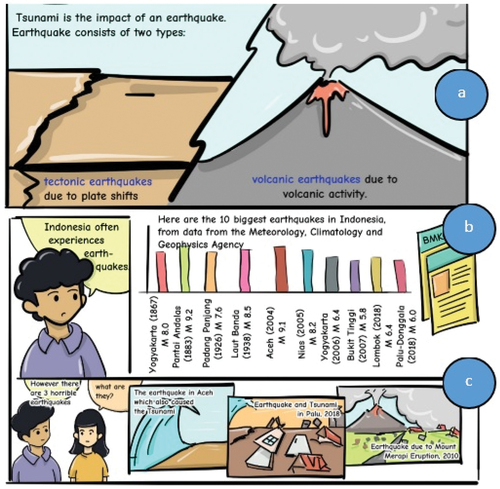
In this discussion, we integrate mathematical representations by showcasing significant earthquake events in Indonesia, each measured with a magnitude of over 5.0 on the Richter Scale (). This approach intends to familiarise students with the notion that earthquakes are natural phenomena frequently experienced in Indonesia. Additionally, this section incorporates the graphical representation of numerical data to aid comprehension and facilitate data analysis.
This section aims to provide elementary school students with foundational knowledge of seismic events in earthquakes through the integration of scientific and mathematical concepts (specifically measurement) to help understand earthquakes – the measurement helps understand how big different earthquakes are (and how some are bigger than others). Utilising scientific explanations to introduce the occurrence of earthquakes is crucial in providing a scientific understanding of this phenomenon. Moreover, incorporating mathematics in this comic serves the purpose of familiarising readers with the calculation of earthquake magnitudes, highlighting the distinctiveness of each seismic event and the utilisation of the Richter scale for measurement. By doing so, readers gain an overview of how earthquakes vary. This integration of science and mathematics in the comic exemplifies the interconnectedness of these two disciplines. By establishing a connection between scientific and mathematical principles, this section ensures a seamless transition to the exploration of social science concepts, demonstrating a coherent progression in the introduction of fundamental knowledge to students.
In the realm of social sciences, we present several notable and impactful earthquake case studies as part of the SSI section (). These examples serve as vivid illustrations, providing students with initial insights into the occurrence of earthquakes and their wide-ranging societal impacts. By presenting these cases, we aim to cultivate a foundational understanding of the complexities surrounding earthquakes and their ramifications on communities.
Socioscientific issues cases part
In this section, our focus is further expanding the foundational knowledge of earthquakes, encompassing scientific, mathematical, and social perspectives. For instance, we examine a specific case study, Case 1, which describes the tsunami incident in Aceh that was triggered by a tectonic earthquake in the ocean depths, as depicted in . From a social standpoint, we explicitly illustrate the extensive impact of the tsunami on the affected region. Moreover, we fortify this with a mathematical perspective by presenting data on the infrastructure damage caused by the tsunami, effectively represented through bar charts (). Furthermore, we provide scientific insights into the mechanisms underlying the occurrence of tsunamis ().
Figure 5. Case 1 of SSI related to the tsunami in aceh: (a) mathematical representation of the aceh tsunami’s damage to infrastructure; (b) scientific explanation of causes of tsunamis.
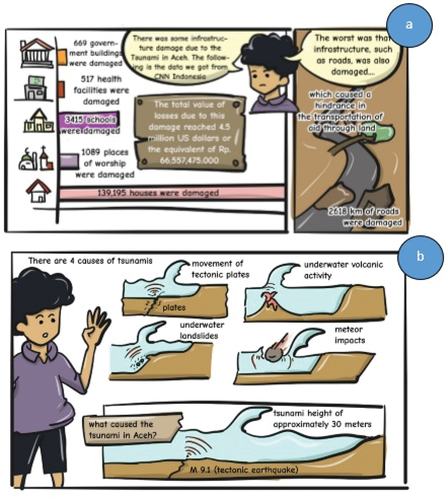
For the second SSI, we examine the case of the Palu earthquake, which took place in Indonesia in 2018. Similarly, to previous sections, we adopt a multidimensional approach we adopt a multidimensional approach using mathematical and graphical representations to consider the social and scientific aspects, as depicted in . We delineate the repercussions following the disaster, highlighting the magnitude of the impact on various fronts. Additionally, we present numerical data as a bar chart, specifically focusing on the extent of damage sustained by residential structures. Moreover, we provide insights into post-disaster occurrences, including the recorded death toll and infrastructure damage, emphasising the interconnectedness of social, science, and mathematics, where we used mathematical aspects of the aftermath of such events.
Socioscientific issues case discussion part
Based on the selected cases, we devised sections within the comic to encourage students’ active participation and promote critical thinking. exemplifies one such section where students are prompted to interpret data represented in graphical form. Furthermore, we engage students in contemplating their hypothetical role as leaders in the aftermath of an earthquake, encouraging them to reflect on the actions they would take. Additionally, we prompt students to consider the perspective of being victims of an earthquake, fostering empathy and deepening their understanding of the experiences faced by those affected.
This discussion segment holds significant importance as it allows teachers to assess students’ reasoning abilities and gauge their capacity to integrate prior knowledge with the information acquired through the comics. Engaging in these thought-provoking discussions encourages students to connect their existing knowledge and the concepts conveyed in the comic, promoting a deeper comprehension and critical analysis of the subject matter.
Conclusion part
The conclusion section offers a summary that consolidates the information presented throughout the comic. In this instance, we also emphasise conveying important messages and recommendations about earthquake preparedness (). We believe guiding students regarding actions to be taken before, during, and after an earthquake is crucial. This approach is significant as the comic not only imparts knowledge but also aims to equip students with practical suggestions for disaster mitigation. By incorporating these actionable recommendations, we aim to empower students to actively engage in proactive measures and contribute to their communities’ overall preparedness and safety.
Discussion
This comics design combines science and mathematics to depict the content of socioscientific issues, creating an enriching and captivating educational journey. Employing the rule-of-five framework, we developed comics that embrace a multidisciplinary approach. By combining science and mathematics, we deliver earthquake-related content in a visually engaging narrative within the comic. This discussion section delves into the intricate details of the comic’s format design, exploring how science and mathematics converge to convey the essence of sociocentric issues.
The overall principle in this comics design is organised into five sections: introduction, basic knowledge, socioscientific issues, discussion of SSI, and conclusion. The content of these sections follows the rule-of-five framework (Diaz Eaton et al. Citation2019), which guides the integration of multiple academic disciplines within the comic. The sections aim to support students’ understanding of SSI scenarios systematically. Additionally, the combination of different academic disciplines here is to support the SSI framework, which requires a cross-disciplinary perspective in its design (Zeidler et al. Citation2005). A cross-disciplinary perspective is required because issues cannot be fully understood from the viewpoint of just one academic discipline; a holistic approach is necessary. Hence, we enrich the use of mathematical representation in the comic.
In constructing our comic, we strive to introduce the characters at the beginning of the story and create different visual depictions of each character to facilitate easy recognition by students. Furthermore, some character has their backstory; when looking at Ali and Ira, they are just ordinary children discussing earthquakes. However, there is a third character named Juna who had firsthand experience as one of the earthquake victims (). Various studies on comics emphasise the importance of differentiating characters to avoid confusion among readers when interpreting dialogues between characters (Borkent Citation2017; Imaizumi et al. Citation2021; Pratt Citation2009). The introduction of characters also serves the purpose of acquainting readers with their traits and physical appearances, enabling them to follow the comic’s narrative more efficiently (Borkent Citation2017). The backstory or origin of a character also influences the course of a comic’s narrative. In this comic, for instance, Juna’s presence as an earthquake victim enriches the storytelling. Previous studies have also reported that the background story of comic characters plays a crucial role in the plot development of the comic (Imaizumi et al. Citation2021; Pratt Citation2009).
In addition to character introductions, we provide general information about the factors contributing to Indonesia’s earthquake susceptibility. This inclusion of general information serves as a form of apperception, preparing students before delving into the core content of the comic (Cohn Citation2013a, Citation2013b; Jenkins Citation2012; Meskin and Cook Citation2012). We offer this introductory information to generate initial intrigue and captivate readers, stimulating their interest and drawing them further into the comics contents. Thus, this section plays a crucial role as an initial catalyst, enticing students and guiding them towards the following content.
Regarding foundational knowledge, information plays a pivotal role in educational comics, as demonstrated by various studies in this field. Sections comprising subject matter content are crucially developed to serve as the informational core, akin to the main content found in textbooks (Cohn Citation2014). However, the incorporation of visual elements sets the basic knowledge content in comics apart from traditional books (Andersen and De Rooy Citation2022; Bramlett Citation2016). The visual synergy employed in comics aids readers in comprehending the intended information, enhancing their understanding of the subject matter (Bongco Citation2000; Wood Citation2015).
Our comics stand out by incorporating a blend of mathematics and science to explain SSI. The mathematical aspect is conveyed through visually representing earthquake-related data. We specifically emphasise the use of bar charts to present selected data. We chose to use bar charts because research indicates that bar charts are more suitable for elementary school students compared to other graph types like line graphs (Farokhah, Herman, and Jupri Citation2019; Fauzan, Kusnadi, and Sofyan Citation2023; Perks and Prestage Citation2000). The advantage of bar charts lies in their ability to separate and categorise nominal data (Sharma Citation2020). The data used in this section is collected from various reliable sources, including the Indonesian Meteorological, Climatological, and Geophysics Agency, as well as reputable newspapers in Indonesia (BMKG Citation2013; CNN Indonesia Citation2021). In essence, the integration of mathematical representations in our comics establishes a solid foundation for understanding data and introduces students to the skill of data interpretation.
In the realm of science, our comics place a stronger emphasis on conceptual understanding and explanations related to earthquakes. To facilitate comprehension of how earthquakes occur, we provide an overview that helps elementary school students become more acquainted with potentially unfamiliar terms, such as ‘earth plate’ or ‘volcanic activity’. Consistent with previous studies, educational comics excel in visually presenting information on fundamental scientific concepts, making it more accessible to readers compared to text-only information (Abdullah et al. Citation2019; Akcanca Citation2020; Barberis and Grüning Citation2021). Within this comic, the science section offers a basic understanding of scientific explanations for the depicted events.
In the section dedicated to SSI, we integrate social sciences with science and mathematics. This integration aligns with the SSI framework, particularly the multidisciplinary perspective (Zeidler et al. Citation2005), which imparts to students the interconnected nature of various aspects within an issue. Students are exposed to the idea that complex issues entail multiple interrelated factors by presenting the content from different disciplinary approaches. Numerous studies highlight the importance of examining issues from diverse perspectives, as it enhances students’ reasoning abilities by providing them with a wealth of rich and varied viewpoints (Cian Citation2020; Eastwood, Schlegel, and Cook Citation2011). The abundance of information within the SSI context instils in students the understanding that issues are multifaceted and not confined to narrow considerations.
In the discussion section, we assign students tasks that involve examining and comparing data. This approach is crucial as it simultaneously stimulates their statistical literacy and allows us to assess students’ comprehension of data presentation (Çatman Aksoy and Işıksal Bostan Citation2021; Hourigan and Leavy Citation2020). By incorporating questions requiring interpretation of graphs, we aim to introduce students to the fundamentals of statistical literacy. Several studies have emphasised the significance of utilising visual graphs as a valuable tool in this context, as they greatly facilitate the development of statistical literacy skills among students (Melgar et al. Citation2022; Silvestre and Meireles Citation2021). This approach is an initial step in fostering students’ ability to understand and interpret data through graphical representations.
Moreover, the tasks assigned to students involve assuming different roles, such as stakeholders, government officials, or earthquake victims. This aspect is significant since it prompts students to engage in diverse perspectives and think from various positions. It aligns with one of the indicators of socioscientific reasoning, namely perspective-taking (Kahn and Zeidler Citation2019; Newton and Zeidler Citation2020). Introducing SSI through perspective-taking is crucial as it helps students understand that different individuals or groups hold distinct viewpoints when faced with an issue (Fancourt and Guilfoyle Citation2022). By encouraging students to consider multiple perspectives, we aim to instil the awareness that various factors and contexts can shape their perspectives.
The final section of our comics, the conclusion, summarises the presented material. Additionally, our comic also provides practical tips for students, specifically on responding during an earthquake. Furthermore, we emphasise the actions students can take in terms of earthquake mitigation measures before, during, and after an earthquake. This adaptation is inspired by studies highlighting the fruitfulness of incorporating messages after a lesson to convey significant ideas or information to students (Cheng Citation2012). By presenting these tips and mitigation strategies, we aim to empower students with actionable knowledge to improve their safety and well-being in earthquake-prone areas.
Our aim is to establish a framework for integrating knowledge from both science and mathematics in the presentation of SSI. We hope this comic will serve as a valuable tool to enhance students’ comprehension of the comic’s content and facilitate the successful integration of SSI into the learning process.
Conclusion
In conclusion, this study has explored the development of an educational comic that integrates science, mathematics, and socioscientific issues (SSI) in its content. Through careful design, the comic aims to introduce characters and story, provide basic knowledge on earthquakes, present scientific explanations, and engage students in discussions of SSI and interpretation of data. The unique combination of mathematics and science in visualising data and the integration of SSI offers a comprehensive and multidisciplinary approach to enhance students’ understanding and reasoning abilities.
The paper emphasises the importance of visual representations, such as graphs and bar charts, in facilitating comprehension and statistical literacy among elementary school students. It also highlights the significance of perspective-taking and exploring different stakeholder roles in SSI discussions. By incorporating messages and suggestions for earthquake preparedness and mitigation, the comic imparts knowledge and encourages practical actions and critical thinking.
While the comic is still in the design phase and has yet to be tested, the authors anticipate that it will be an effective educational tool for enhancing students’ understanding of scientific concepts, mathematical representations, and SSI. The upcoming trial phase will provide valuable insights into the effectiveness of the comic in promoting student engagement, comprehension, and the integration of SSI in the learning process.
This research contributes to developing innovative educational resources bridging the gap between science, mathematics, and socioscientific issues. It highlights the potential of educational comics as engaging and multidimensional mediums for knowledge acquisition, critical thinking, and the cultivation of informed and responsible citizens. Future research should focus on evaluating the impact of the comic on student learning outcomes and exploring additional strategies for enhancing the integration of SSI in educational contexts.
Supplemental Material
Download MS Word (3.3 MB)Acknowledgement
This publication received support from the Johannes Kepler University’s Publication Fund. We acknowledge the use of Chat GPT 3.5 for final-stage editing of our writing, employing prompts such as ‘Please check the grammar of my writing’ and ‘Paraphrase my writing into scientific paragraph’. Additionally, we used Grammarly to verify and ensure the accuracy of grammar corrections.
Disclosure statement
No potential conflict of interest was reported by the author(s).
Supplementary Material
Supplemental data for this article can be accessed online at https://doi.org/10.1080/21504857.2023.2292734.
Correction Statement
This article has been corrected with minor changes. These changes do not impact the academic content of the article.
References
- Abdullah, N., M. Adna, L. F. Ibharim, W. H. Tan, D. Janan, J. M. Abdullah, N. Idris, and A. S. A. Wahab. 2019. “The Development of Year One Stem Comic for Science and Mathematics Subject.” Journal of Engineering and Science Research 3 (6): 11–20. https://doi.org/10.26666/rmp.jesr.2019.6.3.
- Aisya, N., Y. Wibowo, and T. Aminatun. 2016. “The Influence of Socio-Scientific Issues on Reflective Judgment of High School’s Student in Ecosystem Material.” Jurnal Bioedukatika 4 (2): 14–18. https://doi.org/10.26555/bioedukatika.v4i2.5346.
- Akcanca, N. 2020. “An Alternative Teaching Tool in Science Education: Educational Comics.” International Online Journal of Education and Teaching 7 (4): 1550–1570.
- Andersen, C. B., and R. De Rooy. 2022. “Employment Agreements in Comic Book Form-What a Difference Cartoons Make.” In Research Handbook on Contract Design, edited by Marcelo Corrales Compagnucci, Helena Haapio, and Mark Fenwick, 329–346. Cheltenham: Edward Elgar Publishing.
- Barberis, E., and B. Grüning. 2021. “Doing Social Sciences via Comics and Graphic Novels. An Introduction.” Sociologica 15 (1): 125–142.
- BMKG. 2013. “Gempabumi Terkini (M ≥ 5.0).” Badan Meteorologi, Klimatologi Dan Geofisika Indonesia. https://www.bmkg.go.id/gempabumi-terkini.html.
- Bongco, M. 2000. Reading Comics Language, Culture, and the Concept of the Superhero in Comic Books. New York: Routledge. https://doi.org/10.4324/9781315805030.
- Borkent, M. 2017. “Mediated Characters: Multimodal Viewpoint Construction in Comics.” Cognitive Linguistics 28 (3): 539–563. https://doi.org/10.1515/cog-2016-0098.
- Bramlett, F. 2016. “Comics and Linguistics.” In The Routledge Companion to Comics, edited by Frank Bramlett, Roy T. Cook, and Aaron Meskin, 396–405. New York and London: Routledge.
- Cahyarini, A., S. Rahayu, and Y. Yahmin. 2016. “The Effect of 5e Learning Cycle Instructional Model Using Socioscientific Issues (SSI) Learning Context on Students’ Critical Thinking.” Jurnal Pendidikan IPA Indonesia 5 (2): 222–229. https://doi.org/10.15294/jpii.v5i2.7683.
- Çatman Aksoy, E., and M. Işıksal Bostan. 2021. “Seventh graders’ Statistical Literacy: An Investigation on Bar and Line Graphs.” International Journal of Science and Mathematics Education 19 (2): 397–418. https://doi.org/10.1007/s10763-020-10052-2.
- Cheng, S. W. 2012. ““That’s It for today”: Academic Lecture Closings and the Impact of Class Size.” English for Specific Purposes 31 (4): 234–248. https://doi.org/10.1016/j.esp.2012.05.004.
- Cian, H. 2020. “The Influence of Context: Comparing High School students’ Socioscientific Reasoning by Socioscientific Topic.” International Journal of Science Education 42 (9): 1503–1521. https://doi.org/10.1080/09500693.2020.1767316.
- CNN Indonesia. 2021. “17 Tahun Tsunami Aceh, Mengingat Kembali Bencana di Ujung Banda.” CNN Indonesia. https://www.cnnindonesia.com/nasional/20211226080343-20-738730/17-tahun-tsunami-aceh-mengingat-kembali-bencana-di-ujung-banda.
- Cohn, N. 2013a. “Navigating Comics: An Empirical and Theoretical Approach to Strategies of Reading Comic Page Layouts.” Frontiers in Psychology 4 (April): 1–15. https://doi.org/10.3389/fpsyg.2013.00186.
- Cohn, N. 2013b. The Visual Language of Comics: Introduction to the Structure and Cognition of Sequential Images. London: A&C Black.
- Cohn, N. 2014. “The Architecture of Visual Narrative Comprehension: The Interaction of Narrative Structure and Page Layout in Understanding Comics.” Frontiers in Psychology 5:680. https://doi.org/10.3389/fpsyg.2014.00680.
- Dawson, V. 2015. “Western Australian High School students’ Understandings About the Socioscientific Issue of Climate Change.” International Journal of Science Education 37 (7): 1024–1043. https://doi.org/10.1080/09500693.2015.1015181.
- Diaz Eaton, C., H. C. Highlander, K. D. Dahlquist, G. Ledder, M. D. LaMar, and R. C. Schugart. 2019. “A “rule-of-five” framework for models and modeling to unify mathematicians and biologists and improve student learning.” Primus 29 (8): 799–829. https://doi.org/10.1080/10511970.2018.1489318.
- Dolan, T. J., B. H. Nichols, and D. L. Zeidler. 2009. “Using socioscientific issues in primary classrooms.” Journal of Elementary Science Education 21 (3): 1–12. https://doi.org/10.1007/BF03174719.
- Eastwood, J. L., W. M. Schlegel, and K. L. Cook. 2011. “Effects of an Interdisciplinary Program on students’ Reasoning with Socioscientific Issues and Perceptions of Their Learning Experiences.” In Socio-Scientific Issues in the Classroom, edited by Troy D. Sadler, 89–126. Dordrecht: Springer.
- Evagorou, M. 2011. “Discussing a Socioscientific Issue in a Primary School Classroom: The Case of Using a Technology-Supported Environment in Formal and Nonformal Settings.” In Socio-Scientific Issues in the Classroom, edited by Troy D. Sadler, 133–159. Dordrecht: Springer.
- Fancourt, N., and L. Guilfoyle. 2022. “Interdisciplinary Perspective-Taking within Argumentation: Students’ Strategies Across Science and Religious Education.” Journal of Religious Education 70 (1): 1–23. https://doi.org/10.1007/s40839-021-00143-9.
- Farokhah, L., T. Herman, and A. Jupri. 2019. “Students’ Ability of Mathematical Representation on Statistics Topic in Elementary School.” 1157 (3): 032110. https://doi.org/10.1088/1742-6596/1157/3/032110.
- Fauzan, B. A., D. Kusnadi, and A. Sofyan. 2023. “Changes in Students’ Cognitive Abilities Through STEM-Based Learning in Elementary Schools.” Mosharafa: Jurnal Pendidikan Matematika 12 (1): 89–100. https://doi.org/10.31980/mosharafa.v12i1.2122.
- Goltz, J. D., H. Park, G. Nakano, and K. Yamori. 2020. “Earthquake Ground Motion and Human Behavior: Using DYFI Data to Assess Behavioral Response to Earthquakes.” Earthquake Spectra 36 (3): 1231–1253. https://doi.org/10.1177/8755293019899958.
- Gunawan, E., S. Widiyantoro, G. I. Marliyani, E. Sunarti, R. Ida, and A. R. Gusman. 2019. “Fault Source of the 2 September 2009 Mw 6.8 Tasikmalaya Intraslab Earthquake, Indonesia: Analysis from GPS Data Inversion, Tsunami Height Simulation, and Stress Transfer.” Physics of the Earth and Planetary Interiors 291:54–61. https://doi.org/10.1016/j.pepi.2019.04.004.
- Hourigan, M., and A. M. Leavy. 2020. “Using Integrated STEM as a Stimulus to Develop Elementary students’ Statistical Literacy.” Teaching Statistics 42 (3): 77–86. https://doi.org/10.1111/test.12229.
- Imaizumi, K., R. Yamanishi, Y. Nishihara, and T. Ozawa 2021. “Estimating Groups of Featured Characters in Comics with Sequence of characters’ Appearance.” 13–18.
- Indriani, T., and U. N. A. D. Jayanti. 2022. “Interactive Socio-Scientific Inquiry: The Effects on Creative Thinking Skills.” Jurnal Pendidikan MIPA 23 (3): 995–1005. https://doi.org/10.23960/jpmipa/v23i3.pp995-1005.
- Jenkins, H. R. 2012. “Introduction: Should We Discipline the Reading of Comics?.” In Critical Approaches to Comics, edited by M. J. Smith and R. Duncan, 19–32. New York: Routledge.
- Kahn, S., and D. L. Zeidler. 2019. “A Conceptual Analysis of Perspective Taking in Support of Socioscientific Reasoning.” Science & Education 28 (6–7): 605–638. https://doi.org/10.1007/s11191-019-00044-2.
- Katili, J. A. 1975. “Volcanism and Plate Tectonics in the Indonesian Island Arcs.” Tectonophysics 26 (3–4): 165–188. https://doi.org/10.1016/0040-1951(75)90088-8.
- Lee, H., J. Yoo, K. Choi, S.-W. Kim, J. Krajcik, B. C. Herman, and D. L. Zeidler. 2013. “Socioscientific Issues as a Vehicle for Promoting Character and Values for Global Citizens.” International Journal of Science Education 35 (12): 2079–2113. https://doi.org/10.1080/09500693.2012.749546.
- Lubis, M. A. 2018. “The Development of Teaching Comics to Improve Interest in Reading Civic Education in Min Ramba Padang, South Tapanuli Regency, Indonesia.” Budapest International Research and Critics Institute-Journal (BIRCI-Journal) 1 (3): 71–83. https://doi.org/10.33258/birci.v1i3.31.
- Melgar, Á. S., D. Fuster-Guillen, R. A. R. Lozano, and E. Gálvez-Suárez. 2022. “Infographics in the Literacy of Statistical Skills in University Students.” Journal of Pharmaceutical Negative Results 13 (2): 474–481. https://doi.org/10.47750/pnr.2022.13.S02.69.
- Meskin, A., and R. T. Cook. 2012. “The Art of Comics: A Philosophical Introduction.” In The Art of Comics: A Philosophical Approach, 25. New Jersey: Blackwell Publishing Ltd. https://doi.org/10.1002/9781444354843.
- Newton, M. H., and D. L. Zeidler. 2020. “Developing Socioscientific Perspective Taking.” International Journal of Science Education 42 (8): 1302–1319. https://doi.org/10.1080/09500693.2020.1756515.
- Pambudi, N. A. 2018. “Geothermal Power Generation in Indonesia, a Country within the Ring of Fire: Current Status, Future Development and Policy.” Renewable and Sustainable Energy Reviews 81:2893–2901. https://doi.org/10.1016/j.rser.2017.06.096.
- Perks, P., and S. Prestage. 2000. “Bar and Pie Charts: Ideas for the Classroom.” Teaching Statistics 22 (2): 52–55. https://doi.org/10.1111/1467-9639.00019.
- Pratt, H. J. 2009. “Narrative in Comics.” The Journal of Aesthetics & Art Criticism 67 (1): 107–117. https://doi.org/10.1111/j.1540-6245.2008.01339.x.
- Presley, M. L., A. J. Sickel, N. Muslu, D. Merle-Johnson, S. B. Witzig, K. Izci, and T. D. Sadler. 2013. “A Framework for Socio-Scientific Issues Based Education.” Science Educator 22 (1): 26–32.
- Sharma, A. M. 2020. “Data visualization.” In Data Science and Analytics, edited by S. Kumari, K. K. Tripathy, and V. Kumbhar, 1–22. Bingley: Emerald Publishing Limited.
- Silvestre, C., and A. Meireles. 2021. “Learning Statistics Using Infographics: A Powerful Tool to Engage Communication Students in Learning Activities.” In INTED2021 Proceedings15th International Technology, Education and Development Conference, Valencia, Spain Vol. 15. 7074–7081. Spain. March 2021. https://doi.org/10.21125/inted.2021.1408.
- Solbes, J., N. Torres, and M. Traver. 2018. “Use of Socio-Scientific Issues in Order to Improve Critical Thinking Competences.” Asia-Pacific Forum on Science Learning and Teaching 19 (1): 1–22.
- Susilawati, S., N. Aznam, P. Paidi, and I. Irwanto. 2021. “Socio-Scientific Issues as a Vehicle to Promote Soft Skills and Environmental Awareness.” European Journal of Educational Research 10 (1): 161–174. https://doi.org/10.12973/eu-jer.10.1.161.
- Verstappen, H. T. 2010. “Indonesian Landforms and Plate Tectonics.” Indonesian Journal on Geoscience 5 (3): 197–207. https://doi.org/10.17014/ijog.v5i3.103.
- Wood, M. 2015. The Effect of Graphic Novel Supplements on Reading Comprehension and Motivation in Secondary Students. Arkansas: University of Central Arkansas.
- Wu, S.-Y., and K.-K. Yang. 2022. “Influence and Behavioral Pattern of University students’ Participation in Decision-Making on Socio-Scientific Issues.” Research in Science & Technological Education 1–19. https://doi.org/10.1080/02635143.2022.2093345.
- Zeidler, D. L. 2014. “Socioscientific Issues as a Curriculum Emphasis. Theory, Research, and Practice.” In Handbook of Research on Science Education, Volume II Edition: II, edited by N. G. Lederman and S. K. Abell, 697–726. New York: Routledge.
- Zeidler, D. L., T. D. Sadler, M. L. Simmons, and E. V. Howes. 2005. “Beyond STS: A Research‐Based Framework for Socioscientific Issues Education.” Science Education 89 (3): 357–377. https://doi.org/10.1002/sce.20048.

